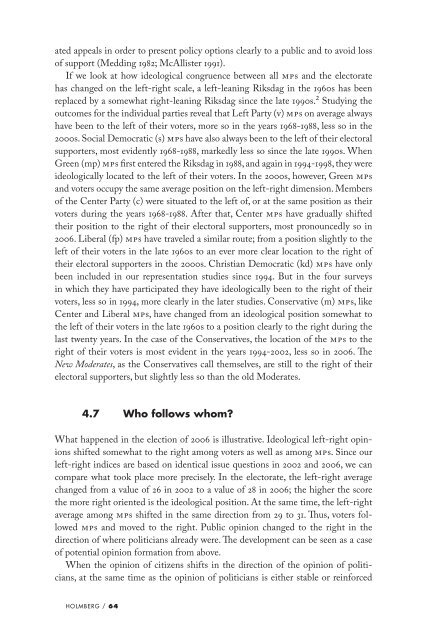download - UvA DARE
download - UvA DARE
download - UvA DARE
You also want an ePaper? Increase the reach of your titles
YUMPU automatically turns print PDFs into web optimized ePapers that Google loves.
ated appeals in order to present policy options clearly to a public and to avoid loss<br />
of support (Medding 1982; McAllister 1991).<br />
If we look at how ideological congruence between all MPs and the electorate<br />
has changed on the left-right scale, a left-leaning Riksdag in the 1960s has been<br />
replaced by a somewhat right-leaning Riksdag since the late 1990s.2 Studying the<br />
outcomes for the individual parties reveal that Left Party (v) MPs on average always<br />
have been to the left of their voters, more so in the years 1968-1988, less so in the<br />
2000s. Social Democratic (s) MPs have also always been to the left of their electoral<br />
supporters, most evidently 1968-1988, markedly less so since the late 1990s. When<br />
Green (mp) MPs first entered the Riksdag in 1988, and again in 1994-1998, they were<br />
ideologically located to the left of their voters. In the 2000s, however, Green MPs<br />
and voters occupy the same average position on the left-right dimension. Members<br />
of the Center Party (c) were situated to the left of, or at the same position as their<br />
voters during the years 1968-1988. After that, Center MPs have gradually shifted<br />
their position to the right of their electoral supporters, most pronouncedly so in<br />
2006. Liberal (fp) MPs have traveled a similar route; from a position slightly to the<br />
left of their voters in the late 1960s to an ever more clear location to the right of<br />
their electoral supporters in the 2000s. Christian Democratic (kd) MPs have only<br />
been included in our representation studies since 1994. But in the four surveys<br />
in which they have participated they have ideologically been to the right of their<br />
voters, less so in 1994, more clearly in the later studies. Conservative (m) MPs, like<br />
Center and Liberal MPs, have changed from an ideological position somewhat to<br />
the left of their voters in the late 1960s to a position clearly to the right during the<br />
last twenty years. In the case of the Conservatives, the location of the MPs to the<br />
right of their voters is most evident in the years 1994-2002, less so in 2006. The<br />
New Moderates, as the Conservatives call themselves, are still to the right of their<br />
electoral supporters, but slightly less so than the old Moderates.<br />
4.7 Who follows whom?<br />
What happened in the election of 2006 is illustrative. Ideological left-right opinions<br />
shifted somewhat to the right among voters as well as among MPs. Since our<br />
left-right indices are based on identical issue questions in 2002 and 2006, we can<br />
compare what took place more precisely. In the electorate, the left-right average<br />
changed from a value of 26 in 2002 to a value of 28 in 2006; the higher the score<br />
the more right oriented is the ideological position. At the same time, the left-right<br />
average among MPs shifted in the same direction from 29 to 31. Thus, voters followed<br />
MPs and moved to the right. Public opinion changed to the right in the<br />
direction of where politicians already were. The development can be seen as a case<br />
of potential opinion formation from above.<br />
When the opinion of citizens shifts in the direction of the opinion of politicians,<br />
at the same time as the opinion of politicians is either stable or reinforced<br />
holmberg / 64
















